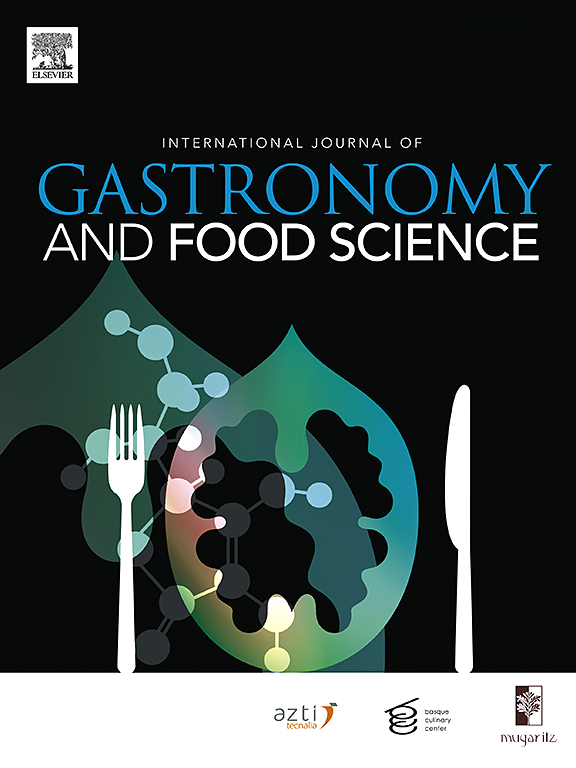Effect of microwave pretreatment and adding strategies of Hongqu lees on the physicochemical properties and microbial communities of fermented large yellow croaker sauce
IF 3.2
2区 农林科学
Q2 FOOD SCIENCE & TECHNOLOGY
International Journal of Gastronomy and Food Science
Pub Date : 2025-01-04
DOI:10.1016/j.ijgfs.2025.101106
引用次数: 0
Abstract
The Aromatic Lees Large Yellow Croaker is a traditional solid-state fermented product from the southeastern coast of China. The liquid fermentation method for making fermented large yellow croaker sauce (LYCS) is a new attempt to obtain a unique fermented flavor more efficiently based on the traditional fermentation method. Hongqu lees impart unique flavors to fermentation, and different amounts of Hongqu lees added lead to fermentation systems with different initial physicochemical and microbiological properties. Microwave pretreatment before fermentation (MWP) was introduced as a key innovation technique aimed at reducing undesirable microorganisms in the fermentation raw material and enhancing the release of flavors in the fermentation. This study investigated the effects of MWP and different levels of Hongqu lees addition on the physicochemical characteristics and microbial composition of LYCS. MWP increased the total acid (TA), total nitrogen (TN), and trichloroacetic acid (TCA) - soluble peptides contents. Histamine content was significantly reduced by increasing the Hongqu lees addition to L2 (1:0.2 ratio of fish pulp to Hongqu lees). In terms of taste profile, MWP effectively reduces bitterness but also leads to a loss of umami. The main volatiles detected in LYCS were esters and alcohols. Without MWP, LYCS emitted unpleasant volatile odors in the L1 and L2 experimental conditions (1:0.1 and 1:0.2), and MWP effectively reduced these undesirable effects. The dominant bacteria identified in LYCS were Lactobacillus. MWP eliminated Lactococcus, which was derived from large yellow croaker and had a negative effect on LYCS. Moreover, an increase in Hongqu lees additions led to a reduction in the relative abundance of Clostridium. The comprehensive results showed that MWP improved the quality of LYCS, and the optimal addition of Hongqu lees was observed at the L2 level (1:0.2) following MWP. These findings provide a theoretical basis for the development of LYCS as a novel product.
微波预处理及添加策略对发酵大黄鱼酱理化性质及微生物群落的影响
香叶大黄鱼是中国东南沿海地区一种传统的固态发酵产品。液体发酵法制作发酵大黄鱼酱是在传统发酵法的基础上,更有效地获得独特发酵风味的一种新尝试。红曲酒赋予发酵独特的风味,不同的红曲酒添加量导致发酵体系具有不同的初始物理化学和微生物特性。微波发酵前预处理(MWP)是一项关键的创新技术,旨在减少发酵原料中有害微生物的数量,促进发酵过程中风味的释放。本研究考察了MWP和不同添加水平的红曲叶对LYCS理化特性和微生物组成的影响。MWP增加了总酸(TA)、总氮(TN)和三氯乙酸(TCA)可溶性肽的含量。在L2中添加红曲叶(鱼浆与红曲叶的比例为1:0.2)可显著降低组胺含量。在口味方面,MWP有效地减少了苦味,但也导致鲜味的丧失。LYCS中检测到的主要挥发物为酯类和醇类。在没有MWP的情况下,LYCS在L1和L2实验条件下(1:0.1和1:0.2)会产生令人不快的挥发性气味,而MWP有效地减少了这些不良影响。LYCS中鉴定的优势菌为乳酸杆菌。MWP可消除大黄鱼乳球菌,对LYCS有负面影响。此外,红曲叶添加量的增加导致梭状芽孢杆菌的相对丰度降低。综合结果表明,MWP提高了LYCS的质量,在L2水平(1:0.2)下,红曲李的添加量达到最佳。这些发现为LYCS作为一种新型产品的开发提供了理论基础。
本文章由计算机程序翻译,如有差异,请以英文原文为准。
求助全文
约1分钟内获得全文
求助全文
来源期刊

International Journal of Gastronomy and Food Science
Social Sciences-Cultural Studies
CiteScore
5.30
自引率
10.50%
发文量
170
审稿时长
45 days
期刊介绍:
International Journal of Gastronomy and Food Science is a peer-reviewed journal that explicitly focuses on the interface of food science and gastronomy. Articles focusing only on food science will not be considered. This journal equally encourages both scientists and chefs to publish original scientific papers, review articles and original culinary works. We seek articles with clear evidence of this interaction. From a scientific perspective, this publication aims to become the home for research from the whole community of food science and gastronomy.
IJGFS explores all aspects related to the growing field of the interaction of gastronomy and food science, in areas such as food chemistry, food technology and culinary techniques, food microbiology, genetics, sensory science, neuroscience, psychology, culinary concepts, culinary trends, and gastronomic experience (all the elements that contribute to the appreciation and enjoyment of the meal. Also relevant is research on science-based educational programs in gastronomy, anthropology, gastronomic history and food sociology. All these areas of knowledge are crucial to gastronomy, as they contribute to a better understanding of this broad term and its practical implications for science and society.
 求助内容:
求助内容: 应助结果提醒方式:
应助结果提醒方式:


